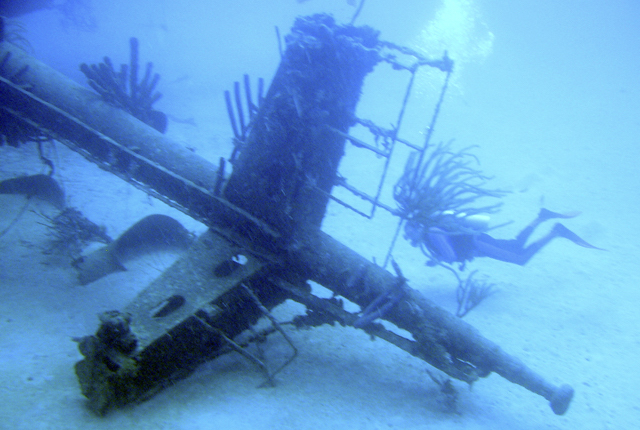After learning how to scuba dive, you might be most excited to see all the reefs, with their brightly colored coral and fish. But the entire ocean is at your fingertips -- and that includes shipwrecks. Shipwrecks litter the ocean floor, and many are within reasonable scuba diving depths. When it comes to wreck diving, the utmost safety precautions must be taken. Divers should never enter a shipwreck unless they have advanced certification, and it should be noted that not all wreck dives permit entrance into the ship itself, due to local laws. Additionally, shipwrecks are often associated with loss of life, so divers should maintain respect. Those who do venture into the deep are rewarded with experiencing the ships’ second life as artificial reefs teaming with sea creatures. Here, we name five diveable wrecks you should put on the top of your bucket list.
1. Hilma Hooker, Bonaire
Courtesy of Flickr/Patrick Briggs
In 1984 this Dutch vessel arrived in Bonaire with engine problems, and upon an inspection of the ship, local authorities discovered 25,000 pounds of marijuana hidden onboard. As the Hilma Hooker was moored offshore while authorities attempted to find its owners, it began taking on water and sank. Today it sits on the sandy bottom between two reefs and is a popular site for divers of all experience levels.
Where to Stay in Bonaire:
2. S.S. President Coolidge, Vanuatu
https://www.instagram.com/p/BNxdoNDDJqU/
Built in 1931, the President Coolidge served as a luxury ocean liner for a decade before being converted into a troopship during World War II. Upon sailing to the U.S. base in Espiritu Santo, Vanuatu, the ship hit two mines, sinking in relatively shallow seas. The 653-foot-long vessel is now one of the top wreck dives in the world, with divers flocking to see “The Lady,” a sculpture of a woman riding a unicorn, and plenty of army supplies.
Where to Stay on the Island of Port Vila, a 50-minute flight from Espiritu Santo:
3. Yongala, Great Barrier Reef, Australia
https://www.instagram.com/p/BR9Z_jnlzOv/
The Yongala was a steamship that sank in a cyclone in 1911, sadly, with the loss of all 121 lives on board. After spending over a century beneath the sea, it has become home to an incredible array of wildlife — many specimens of which are massive, from giant marble rays to giant grouper. Divers often encounter sea turtles, barracuda, sea snakes, and occasionally humpback whales make an appearance nearby. Even if divers can’t see them (though sometimes, they can!), they can hear their calls.
4. Bianca C, Grenada
https://www.instagram.com/p/_zJJZfmQQk/
Called the Titanic of the Caribbean, the 600-foot Bianca C is the largest wreck in these warm waters. The ship sank in Grenada after an explosion rocked its engine room, with its final resting place only a mile offshore from the popular Grand Anse beach. The dive is a little deeper than others — the ship is about 165 feet down — meaning only more advanced divers should swim down.
Where to Stay in Grenada:
5. Oriskany, Pensacola, Florida
https://www.instagram.com/p/sWQ7J_if3v/
Located off the shores of Pensacola, the U.S.S. Oriskany is the largest artificial reef in the world, nicknamed the Great Carrier Reef. The 911-foot aircraft carrier served in World War II and was intentionally sunk in 2006. With such a large ship, the upper levels are only between 80 and 100 feet below the surface, well within reach of less experienced divers, but the hull of the ship rests at 212 feet for those looking for a challenge.
Where to Stay in Pensacola:
You’ll Also Enjoy:
- 5 Best Caribbean Islands for Scuba Diving
- 7 Amazing Dive Hotels Around the World
- 7 Best Dive Spots in the Philippines
All products are independently selected by our writers and editors. If you buy something through our links, Oyster may earn an affiliate commission.



